A NiCu–MoS2 electrocatalyst for pH-universal hydrogen evolution reaction and Zn–air batteries driven self-power water splitting†
Abstract
To accomplish the goal of clean and sustainable energy sources, the development of a trifunctional electrocatalyst is pivotal to promote the sluggish electrocatalytic oxygen evolution, oxygen reduction, and hydrogen evolution reactions, is a boon for future energy storage and conversion devices such as regenerative fuel cells and metal–air batteries. In this study, we reported a mixed-phase (1T and 2H) NiCu–MoS2 having a microflower like morphology with a large number of active sites. The as-synthesized NiCu–MoS2 catalyst exhibits excellent pH-universal hydrogen evolution reaction (HER) activity and attained a current density of 10 mA cm−2 at only 76, 88, and 81 mV under acidic, neutral, and basic conditions with remarkable stability. Beside the superior oxygen evolution reaction (OER), and comparable oxygen reduction reaction (ORR) activity with the benchmark RuO2 and Pt/C catalysts, making it a good trifunctional electro-catalyst for overall water splitting and rechargeable Zn–air batteries. The NiCu–MoS2 based air electrode demonstrates a remarkable power density of 283 mW cm−2, a high energy density, and a superior stability compared to commercial benchmark air cathode. Furthermore, it shows a low cell voltage (1.622 V) in overall water splitting, surpassing most of the previously reported electrocatalysts. Post-stability SEM and XPS studies revealed the morphological stability and generation of the real active sites. More importantly when two Zn–air batteries successfully powered overall self-powered water splitting indicating its huge potential as a trifunctional electro-catalyst for various energy conversion and storage systems.



 Please wait while we load your content...
Please wait while we load your content...